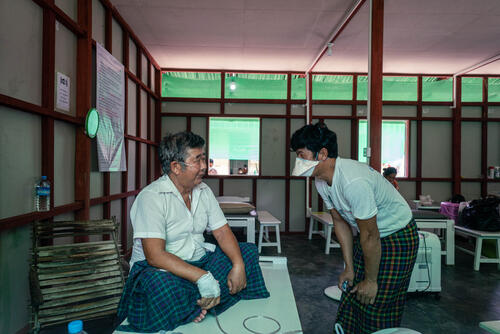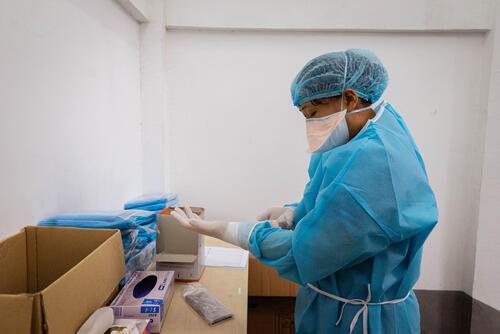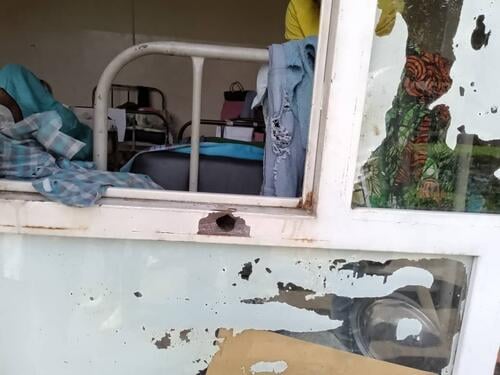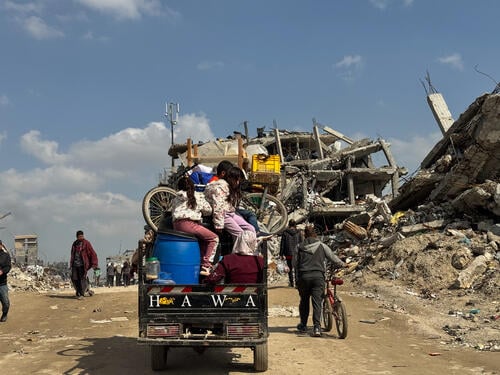Political turmoil and the arrival of COVID-19 has left Myanmar's healthcare system shattered. With 2021 coming to an end, our team on the ground look back at our COVID-19 response, reflecting on what we can be proud of and what we could have done better; the dilemmas, limits and the sometimes-uncomfortable solutions.
Myanmar’s public healthcare system is in disarray. Days after the military seized power on 1 February, medical staff walked out of their jobs, spearheading the civil disobedience movement that saw government employees of all stripes go on strike.
Most have not returned. Those on strike who continue to practice in underground clinics risk being attacked and detained by the authorities. At least 28 healthcare professionals have been killed since 1 February, and nearly 90 remain arrested.
When Myanmar’s beleaguered public healthcare system met with the COVID-19 outbreak, hospitals were quickly overwhelmed.

Overcrowded crematoriums and empty shelves
As COVID-19 infections peaked, beds in hospitals were often impossible to come by and untold numbers of people were scrambling around towns and cities in Myanmar to source their own supplies of oxygen to administer at home.
Crematoriums could not process the bodies fast enough. Routine consultations, surgeries and vaccinations were cancelled while the skeleton medical workforce responded to the outbreak. Panic buying led to empty shelves in pharmacies.
Myanmar’s Ministry of Health counts nearly 20,000-recorded deaths from COVID-19 up to the end of 2021 – the fourth highest mortality rate in south-east Asia. But this figure is misleading – only counting people who died in hospitals. Countless individuals passed away in their homes while facilities were full.

How did MSF respond?
We were granted permission to open three independent COVID-19 treatment centres to receive patients with moderate to severe symptoms in Myanmar’s biggest city Yangon, and Kachin state’s Myitkyina and Hpakant townships.
Remarkably, while some of us fell seriously ill with the virus, no one on the team lost their life to COVID-19, but many of our family members did. Despite this, we pulled together and looked after each other, working overtime to get the centres up-and-running for people we knew were in urgent need of its services.
Although we could not save some patients admitted in very critical condition, some people made remarkable recoveries. One woman living with HIV could barely breathe when she arrived at our facility. But in five days she was off oxygen and could be discharged, making way for another patient.
For others, the progress is slow and steady. One 64-year-old woman was in our Myitkyina clinic for 46 days, slowly improving her lung capacity until her oxygen levels were good enough for her to go home.

When there are no acceptable solutions
Our response could have and should have been bigger. While we had permissions to run independent COVID-19 responses in three locations, not all local health authorities were on the same page.
We had begun supporting a facility in Lashio, the capital of northern Shan state, on 11 August, but one person within the Lashio healthcare structure ordered us to close it down on 15 August. Days after receiving our first patients, we were forced to transfer six people receiving treatment to the military government’s treatment centre, despite their preference to receive care from MSF.
Did we respond in time?
By the time our first treatment centre was up-and-running in early August, COVID-19 was already devastating the country. If we had been better prepared and more reactive, could we have responded sooner and saved more lives? The answer is an uncomfortable yes.
The Delta variant had overwhelmed India and Bangladesh in the months before – two countries that share a 2,000-kilometre border with Myanmar. Its arrival was inevitable. We could have used that time to prepare and equip ourselves, and to have learned from the challenges our colleagues had faced in India where access to oxygen was one of the biggest issues.
When the third wave hit, Myanmar was six months into the military takeover. The team was already working at full stretch to maintain existing activities and fill the gaps left in the struggling public healthcare system, in particular taking on thousands of HIV patients from the state’s National AIDS Programme. By the time we initiated our response in the middle of July, we were already on the back foot.
If we had been better prepared and more reactive, could we have responded sooner and saved more lives? The answer is an uncomfortable yes.The MSF team in Myanmar
We did not always get it right
There was a belief that we could simply put people on oxygen and save lives. This was not the reality of treating COVID-19 patients. Those who are hospitalised with severe symptoms often have underlying conditions, exacerbating their symptoms and complicating their treatment.
We needed essential drugs like insulin and basic cardiovascular medication, but they were not in our warehouse and we could not get them into the country due to convoluted internal processes and difficulties obtaining import permits. We had an emergency preparation kit for COVID-19, but what we had expected to be there was missing, such as medicine to treat blood clots, and the supplies that were included were quickly exhausted.
Committed and ready
Although internal and external constraints and challenges caused difficulties, our COVID-19 facilities are now much more than field clinics – they are excellent hospitals that have saved many lives and will save many more to come.
Only around 13 million people in Myanmar are fully vaccinated – around a quarter of the population. If another wave of infections spreads, the public healthcare system risks being overwhelmed once again. With that in mind, we are maintaining our COVID-19 infrastructure and keeping medical staff on-hand should there be another outbreak.
Although our supplies of essential medicines have improved, importing them remains an issue. Permissions are currently under more scrutiny than prior to the military takeover, delaying shipments. Furthermore, internal MSF processes and policies for local or regional procurement of medicines have not adapted well to the global supply crisis and often hinder emergency purchases.
We have learned many lessons from the challenges we faced the first time round and remain committed and ready to respond to new and unexpected challenges to come.






